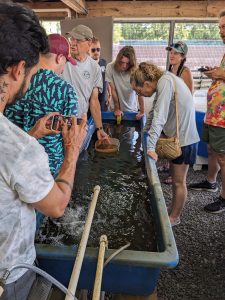
TUSCALOOSA, Ala. – Alabama has the highest diversity of mussels and snails in the country, making it a highly suitable location to hold the American Malacological Society’s 89th annual meeting. Members of the AMS are dedicated to studying the diversity of form, function and ecological breadth of mollusks, and The University of Alabama recently hosted them to discuss their research and appreciation for the invertebrates that live in many of the state’s waterways.
“We were pleased to see every molluscan class covered within our panels, presentations and on our posters during the conference,” said Dr. Kevin Kocot, AMS president and associate professor in UA’s Department of Biological Sciences.
Kocot organized the conference with help from a team of volunteers from UA’s Department of Biological Sciences, Geological Survey of Alabama and Alabama Museum of Natural History.
“We had people who work on all kinds of mollusks and habitats, so we really had a supergroup of researchers,” he said.
The meeting, held in early August, welcomed more than 80 attendees from across the U.S., Germany and Spain. Dr. Carla Atkinson, associate professor in UA’s Department of Biological Sciences, organized and opened the President’s Symposium, “Freshwater Mollusk Diversity in a Biodiversity Hotspot.” The keynote address was given by Dr. Dave Strayer from the Cary Institute.
Over the course of four days, the symposium was followed by more than 70 oral and poster presentations highlighting the diverse subdisciplines of malacology including molluscan genomics, phylogenetics and freshwater molluscan ecology.
While in Tuscaloosa, attendees received a tour of the Alabama Museum of Natural History, which houses several mollusk exhibits. They were also treated to a field trip to the Alabama Aquatic Biodiversity Center, as well as Living River on the Cahaba River, to see some of the state’s 204 species of freshwater snails and 180 species of freshwater mussels.
The AMS was founded in 1931, chiefly through the organizing efforts of Norman W. Lermond, a New England farmer and amateur naturalist. The first meeting of the AMS was held in April and May of that year in Philadelphia, with 29 attendees from 12 states.
To learn more about the AMS, its mission and history, visit the website.